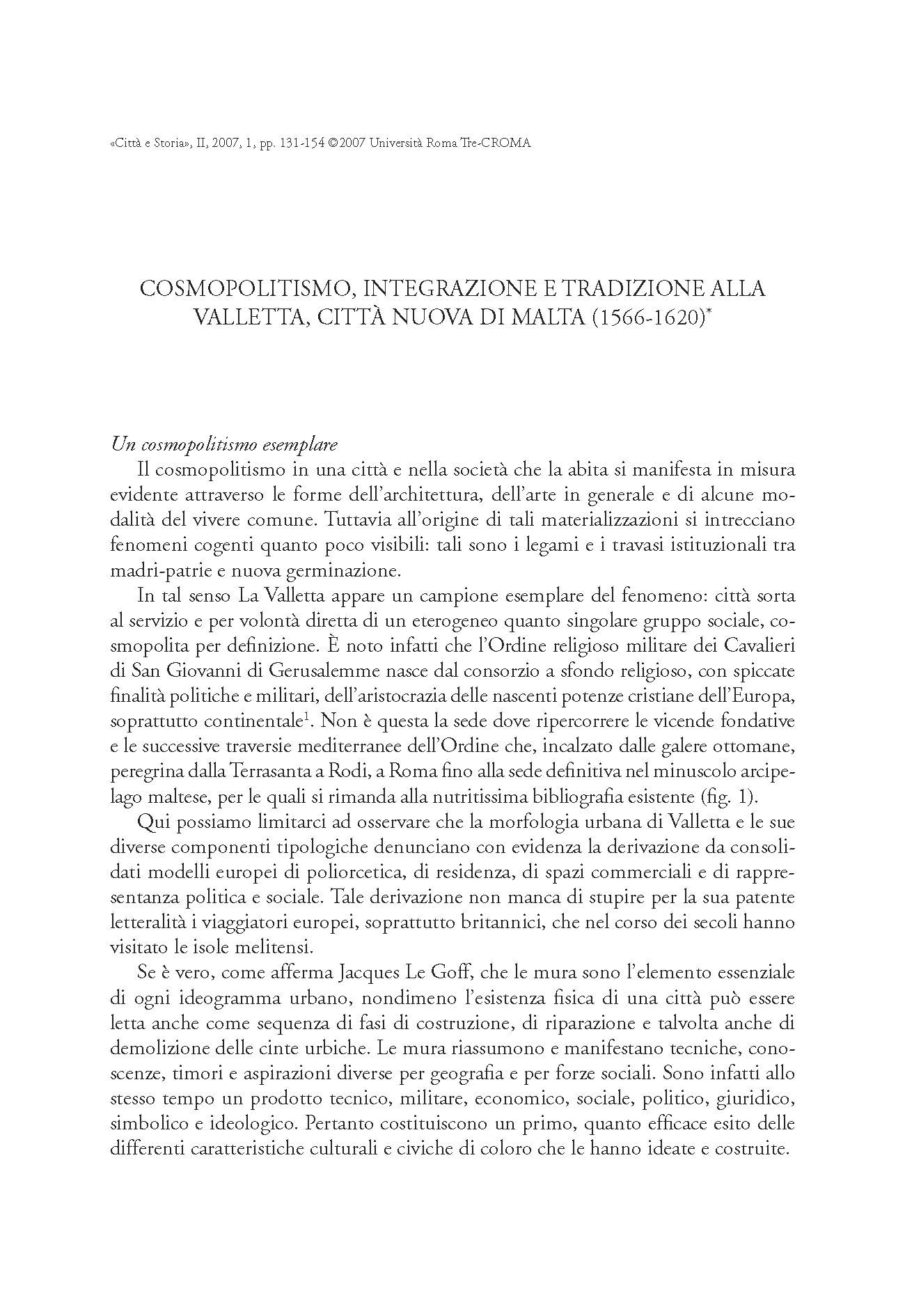Cosmopolitismo, integrazione e tradizione alla Valletta, città nuova di Malta (1566-1620)
6,00 €
Since its formal and functional creation, the city of Valletta has acquired dimensions and characteristics peculiar of a very cosmopolitan capital. Founded in the service and by the will of an heterogeneous and uncommon social class, the military religious Order of the Knights of Saint John of Gerusalem, it showed this distintictive feature through the expressions of architecture, of arts in general and in some customs of social life. However, less visible contributing factors can be identified at the origin of such feature. Among these factors are the cultural connections and institutional relations with the Knights’ countries of origin which demonstrate, through their influence on Valletta’s urban morphology and different building typologies, a direct derivation from well-established European models of siege warfare, residence, social and political representation.
In this context, Valletta’s mighty enclosing walls, built in defence of the city in 1566, summarize and externalize different techniques, knowledges, worries, and aims, varying with geography and social forces involved: Valletta’s fortifications represent at the same time a technical, military, economic, social, political, juridical, symbolic, and ideological product, as well as an effective result of the various cultural and civic characteristics of the people by whom they were planned and erected.
However, if the conception of Valletta’s urban and defensive system was strongly affected by the military and symbolic influence of the European nations represented in the Order, the techniques adopted in its construction join together the building experience, mainly Italian and Spanish, with the native and sicilian building crafts.
In this scenario, the real control, even if often unstated and variously concealed, of the defensive, religious and civilian architectural enterprises was orchestrated by the Roman Curia, which continuously transferred to Malta considerable economic resources for the safeguard of the Mediterranean and Balkan catholic world, threatened by the military and commercial power of its intrusive Ottoman neighbour.
The purpose of this paper is to disentangle such dialectical weaving that originates and realizes the Maltese cosmopolitanism, and makes it a case study of rare demonstrative effectiveness.
Since its formal and functional creation, the city of Valletta has acquired dimensions and characteristics peculiar of a very cosmopolitan capital. Founded in the service and by the will of an heterogeneous and uncommon social class, the military religious Order of the Knights of Saint John of Gerusalem, it showed this distintictive feature through the expressions of architecture, of arts in general and in some customs of social life. However, less visible contributing factors can be identified at the origin of such feature. Among these factors are the cultural connections and institutional relations with the Knights’ countries of origin which demonstrate, through their influence on Valletta’s urban morphology and different building typologies, a direct derivation from well-established European models of siege warfare, residence, social and political representation.
In this context, Valletta’s mighty enclosing walls, built in defence of the city in 1566, summarize and externalize different techniques, knowledges, worries, and aims, varying with geography and social forces involved: Valletta’s fortifications represent at the same time a technical, military, economic, social, political, juridical, symbolic, and ideological product, as well as an effective result of the various cultural and civic characteristics of the people by whom they were planned and erected.
However, if the conception of Valletta’s urban and defensive system was strongly affected by the military and symbolic influence of the European nations represented in the Order, the techniques adopted in its construction join together the building experience, mainly Italian and Spanish, with the native and sicilian building crafts.
In this scenario, the real control, even if often unstated and variously concealed, of the defensive, religious and civilian architectural enterprises was orchestrated by the Roman Curia, which continuously transferred to Malta considerable economic resources for the safeguard of the Mediterranean and Balkan catholic world, threatened by the military and commercial power of its intrusive Ottoman neighbour.
The purpose of this paper is to disentangle such dialectical weaving that originates and realizes the Maltese cosmopolitanism, and makes it a case study of rare demonstrative effectiveness.

